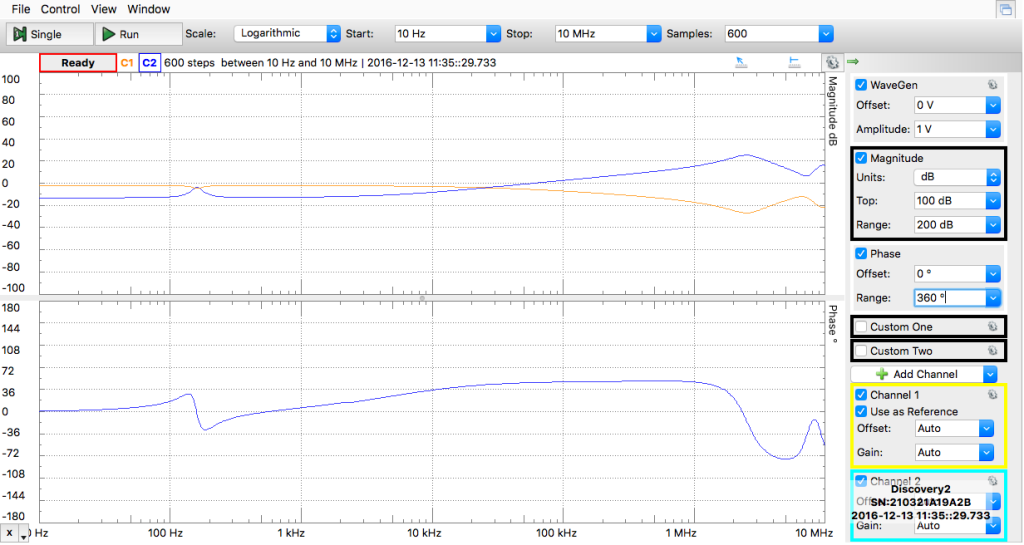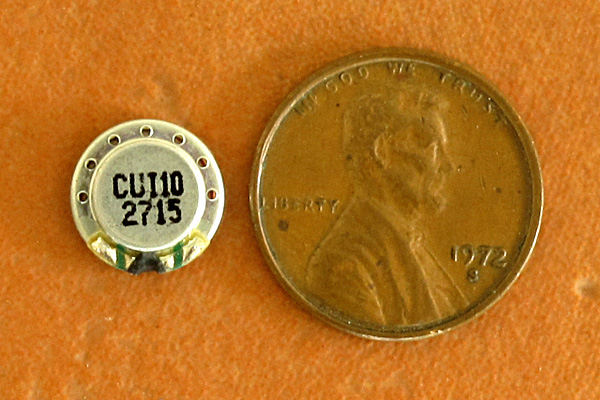In Ultrasonic rangefinder with Analog Discovery 2, I looked at the impedance of an ultrasonic transmitter with the Analog Discovery 2, but I only modeled the transmitter as a capacitor, not modeling the resonances.
So today I collected new data, both for a transmitter and a receiver, using a 1nF C0G (1%) capacitor as the reference impedance, so that I could have clean data from a known pair. I also looked at the transmitter+receiver as a network, and located the peaks of the signal transmission. I was curious whether they corresponded more to transmitter or receiver resonances.

I could model the transmitter quite effectively as a capacitor with 4 LCR resonators in parallel.

I could model the receiver quite effectively as a capacitor with three LCR resonators in parallel.
The fitting was done with gnuplot, fitting one resonance at a time starting with the lowest frequency one, then refitting the previously fit parameters to tweak the fit. The radius of convergence for the fitting is pretty small—I needed to get the LC resonant frequency pretty close to correct before the fitting would converge. Increasing L makes the down-spike and up-spike closer together, and R controls how low the minimum gets, so I could get reasonable initial values (good enough to get convergence) without too much guessing, by plotting using the initial values, adjusting L to get the spacing between the spikes about right, adjusting C to get the resonant frequency right, and doing a rough guess that R is about the minimum value.
The peaks of the transmitter+receiver characteristic seem to correspond most closely to the minimum impedance points of the transmitter, which is reasonable when you consider that I’m driving the transmitter from a fixed voltage—the power is going to be V2/R, so power out is maximized when the impedance is lowest. The one exception is the 331kHz peak, which seems to fall on the higher frequency of the two closely spaced transmitter resonances, and near the peak of receiver impedance. (Of course, only the 40kHz resonance of the transmitter or receiver actually gets used—the other resonances don’t provide nearly as much response in the transmitter+receiver pairing.)

Zooming in on the transmitter impedance for the high-frequency resonances, we can see that there are minor resonances that have not been modeled, but that the model does a good job of capturing the shape of the peaks. The peak of the transmitter+receiver response here falls on the higher-frequency resonance.
I did all my modeling with just the magnitudes of the signals, so it is interesting to see how well the model fits the phase response.

I got excellent matches to the phase response (even when I zoomed in on each peak), except for the low-frequency region, where the impedance seems to have a negative real part (phase < -90°).
I do have models for no resonance, single resonance, two resonances, and three resonances for the transmitter, as well as the four-resonance model. If a simplified model is needed, then it is better to take one of those fits, rather than omitting parts of the more complicated model, as each resonance affects the other parameters somewhat.
As a simple example, the receiver can be modeled as just a 739pF capacitor, but the LCR circuits contribute some of the capacitance, so 708pF gets used for the base capacitor of the model with the 3 resonances.
































